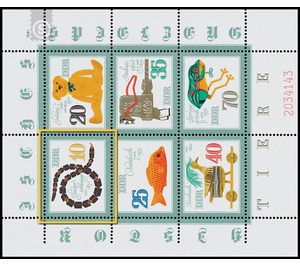Commemorative stamp series - Germany / German Democratic Republic 1981 - 10 Pfennig
Theme: Animals
| Country | Germany / German Democratic Republic |
| Issue Date | 1981 |
| Face Value | 10.00 |
| Color | multi-colored green |
| Perforation | K 13 1/2: 13 |
| Printing Type | offset |
| Stamp Type | Postage stamp |
| Item Type | Stamp |
| Chronological Issue Number | 2403 |
| Chronological Chapter | GER-DDR |
| SID | 373062 |
| In 14 Wishlists | |
Historical Toys - Animals With illustrations of historical toy animals, the Ministry of Posts and Telecommunications of the German Democratic Republic publishes six multicolored special postage stamps printed together on a miniature sheet. No special first day cover envelope Special cancellation from 24th November 1981 to 23rd January 1982 Historic toys - animals Play animals occupy an important place in the motif treasure of the toy today as ever, because their role models are an important part of our environment. They awaken and promote in the child the knowledge of the meaning of the animal for humans, whether as part of the surrounding nature, as a useful pet or as a comrade and playmate. The game animals selected for the special postage stamp issue may stand for this finding. Over a period of two hundred years, to which these testimonies belong, different materials and technical means have been used to design the characteristics of different animals and to develop manageable toys. The painted wooden limestone snake from 1850 (10 Pfennig value) consists of individual wooden links, which - after they were split along their central axis - are glued on both sides on a canvas or leather strip. These wooden links are notched beveled at one end, so that the movements of a snake can be imitated with this toy animal; Also, it can be rolled up to the snake-typical resting position. In the painting of the wooden members, the producers usually let their imagination play. The origin of this toy, which still belonged to the production program of a Sonneberg toy company in the fifties, has not yet been determined exactly. Early evidence can be found in toy pattern books of the Ore Mountains and the Sonneberg area around 1840/50. This special postage stamp issue gives a small outline of the history of the toy since 1800 on the basis of six motifs and shows the change that has taken place in these two hundred years.


